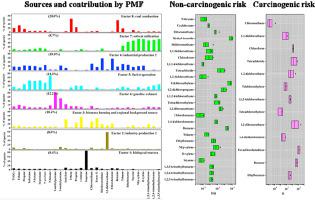Atmospheric Pollution Research ( IF 3.9 ) Pub Date : 2021-03-30 , DOI: 10.1016/j.apr.2021.101053 Sen Yao , Qianheng Wang , Junmei Zhang , Ruinan Zhang , Yixiang Gao , Hanyu Zhang , Jifeng Li , Zhibo Zhou

|
Continuous measurements of volatile organic compounds (VOCs) during the photochemical season in 2018 in a heavy industrial city (Handan, Hebei Province) in the north of China were conducted, and the characteristics, sources, ozone formation potential (OFP) and health risk assessment of VOCs were discussed. The observed mixing ratio of total VOCs was 30.32 ± 15.76 ppbv. The dominant components were alkanes (48.1%), halocarbons (22.6%), aromatics (14.5%), and alkenes (13.6%). According to the potential source contribution function analysis, the main potential source regions were located in the four provinces bordering Handan City, particularly Shandong Province. Eight sources were identified and quantified by positive matrix factorization, with coal combustion (20.0%) being the most significant contributor to the observed VOCs, followed by industrial production 2 (18.0%), fuel evaporation (14.3%), gasoline exhaust (12.2%), biomass burning and regional background sources (10.4%), solvent utilization (8.7%), biological sources (8.4%), and industrial production 1 (8.0%). The OFP result indicated that alkenes (46.9%) and aromatics (36.6%) were responsible for the formation of O3. The sources with the most significant contribution to OFP were solvent utilization (22.2%) and biological sources (21.3%). The VOC non-carcinogenic risks were all below the safe level of 1, whereas the carcinogenic risks of chloroform, tetrachloride, 1,2-dichloroethane, 1,2-dibromoethane, hexachlorobutadiene, and benzene were all higher than the acceptable risk level (1 × 10−6). Industrial production 2 was the largest contributor to non-carcinogenic and carcinogenic risks, whereas solvent utilization was the smallest contributor. The results are conductive to the development of control strategies for VOCs to reduce human exposure to ambient VOCs.











































 京公网安备 11010802027423号
京公网安备 11010802027423号